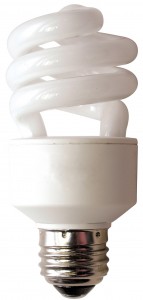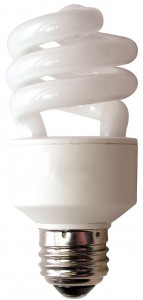There’s been a lot of backlash to the CFL (Compact Fluorescent Lamp) movement recently. Why?
Mercury.

CFLs contain small amounts of mercury. When these bulbs reach the end of their lives (on average 5 or more years – 10 times that of incandescent bulbs), they usually end up in the trash. On the way to the landfill, the bulbs often break which releases the contained mercury. This mercury is now free to contaminate the soil and water eventually water of communities. There’s also some fears that waste management workers will be exposed to high doses of the dangerous neurotoxin.
While we’re all aware of the benefits of CFLs – they use less than 25% of the energy incandescent bulbs use, they save consumers money on their electricity bills, and they also reduces soot and CO2 emissions from coal electricity plants – there’s another key benefit. CFLs release less mercury than incandescent bulbs.
That’s right! All the hype about CFLs and mercury has been a bit misleading.
Wendy Reed, who the runs the Environmental Protection Agency’s (EPA) Energy Star program, says that “even though fluorescent bulbs contain mercury, using them contributes less mercury to the environment than using regular incandescent bulbs. That’s because they use less electricity — and coal-fired power plants are the biggest source of mercury emissions in the air” (NPR).
Yes, its true that CFLs can release mercury to the environment – but it’s less than using incandescents. In order to get the full benefit of the CFL we have to start properly disposing of them. Legislators and the EPA are encouraging bulb manufacturers and sellers like General Electric and Wal-Mart to create easily accessable CFL recycling programs before the mercury scare gives this great product a bad name.
The Bottom Line: Use CFLs. Don’t throw them in the trash.

